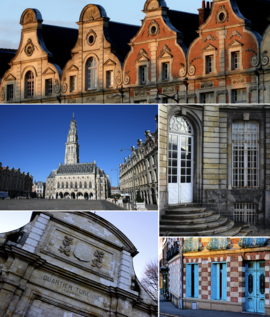
Back Arras Afrikaans Arras AN أراس Arabic اراس ARZ Arras AST Arras Azerbaijani Арас Byelorussian Арас Bulgarian Arras Breton Arràs Catalan
Arras
Aros (Picard) | |
|---|---|
Prefecture and commune | |
 Clockwise from top: a row of Flemish-Baroque-style townhouses, the Saint-Vaast Abbey, a colorful house, the Vauban Citadel, and the Town Hall and its Belfry | |
 | |
| Coordinates: 50°17′31″N 2°46′48″E / 50.292°N 2.780°E | |
| Country | France |
| Region | Hauts-de-France |
| Department | Pas-de-Calais |
| Arrondissement | Arras |
| Canton | Arras-1 Arras-2 Arras-3 |
| Intercommunality | CU d'Arras |
| Government | |
| • Mayor (2020–2026) | Frédéric Leturque[1] |
| Area 1 | 11.63 km2 (4.49 sq mi) |
| Population (2021)[2] | 42,600 |
| • Density | 3,700/km2 (9,500/sq mi) |
| Time zone | UTC+01:00 (CET) |
| • Summer (DST) | UTC+02:00 (CEST) |
| INSEE/Postal code | 62041 /62000 |
| Elevation | 52–99 m (171–325 ft) (avg. 72 m or 236 ft) |
| 1 French Land Register data, which excludes lakes, ponds, glaciers > 1 km2 (0.386 sq mi or 247 acres) and river estuaries. | |
Arras (/ˈærəs/ ARR-əs, French: [aʁɑs] ; Picard: Aros; historical Dutch: Atrecht [ˈaːtrɛxt] ) is the prefecture of the Pas-de-Calais department, which forms part of the region of Hauts-de-France;[3] before the reorganization of 2014 it was in Nord-Pas-de-Calais. The historic centre of the Artois region, with a Baroque town square, Arras is in northern France at the confluence of the rivers Scarpe and Crinchon.[4]
The Arras plain is on a large chalk plateau bordered on the north by the Marqueffles fault, on the southwest by the Artois and Ternois hills, and on the south by the slopes of Beaufort-Blavincourt. On the east it is connected to the Scarpe valley.
Established during the Iron Age by the Gauls,[citation needed] the town of Arras was first known as Nemetocenna, which is believed to have originated from the Celtic word nemeton, meaning 'sacred space'.[citation needed]
Saint Vedast (or St. Vaast) was the first Catholic bishop in the year 499 and tried to eliminate paganism among the Franks. By 843, Arras was seat of the County of Artois which became part of the Royal domain in 1191.[5][unreliable source?] The first mention of the name Arras appeared in the 12th century. Some hypothesize it is a contraction of Atrebates, a Belgic tribe of Gaul and Britain that used to inhabit the area. The name Atrebates could have successively evolved to become Atrades, Atradis, Aras, and finally Arras. Others believe it comes from the Celtic word Ar, meaning 'running water', as the Scarpe river flows through Arras or simply the name of Abraham's wife Sarra spelled backwards.[6][7]
Arras is Pas-de-Calais' third most populous town after Calais and Boulogne-sur-Mer. The town counted 43,693 residents in 2012, with the Arras metropolitan area having a population of 124,200.[8] Arras is located 182 kilometres (113 miles) north of Paris and can be reached in 2 hours by car and in 50 minutes by TGV. It is the historic centre of the former Artois province. Its local speech is characterized as a patois. The city of Arras is well known for its architecture, culture, and history. It was once part of the Spanish Netherlands, a portion of the Low Countries controlled by Spain from 1556 to 1714. Louis XIII reconquered Arras in 1640; the town officially became part of France in 1659.
Arras attracts thousands of visitors every year, who commonly explore the city's architecture and historic buildings. Some attractions include the Town Hall and its Belfry (listed as a UNESCO World Heritage Site since 15 July 2005), the "Boves" (a maze 10 metres (33 feet) beneath the city), the Squares (La Place des Héros and La Grand'Place), the Art District (the Theatre of Arras and the Hôtel de Guînes), the Abbey District (The Saint-Vaast Abbey and the Cathedral of Arras), the Vauban Citadel, and the Nemetacum site (the ancient town founded by the Romans 2000 years ago).[9] The Canadian National Vimy Memorial is just outside the town.
- ^ "Répertoire national des élus: les maires". data.gouv.fr, Plateforme ouverte des données publiques françaises (in French). 2 December 2020.
- ^ "Populations légales 2021" (in French). The National Institute of Statistics and Economic Studies. 28 December 2023.
- ^ INSEE commune file
- ^ Sandre. "Fiche cours d'eau - Crinchon (E2010800)".
- ^ "Eupedia".
- ^ "Histoire Générale - Arras-Online". arras-online.com. Archived from the original on 26 July 2020. Retrieved 30 October 2014.
- ^ "Arras Historique". nordmag.com. Archived from the original on 19 May 2020. Retrieved 30 October 2014.
- ^ "Arras in Nord-Pas-de-Calais -- a Guide to Arras in northern France". gofrance.about.com. Archived from the original on 6 August 2014. Retrieved 30 October 2014.
- ^ "Discover the heritage of the city of Arras - Arras Tourism Office". explorearras.com. Archived from the original on 30 January 2020. Retrieved 30 October 2014.



